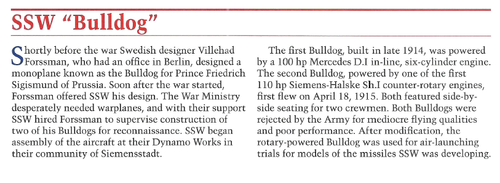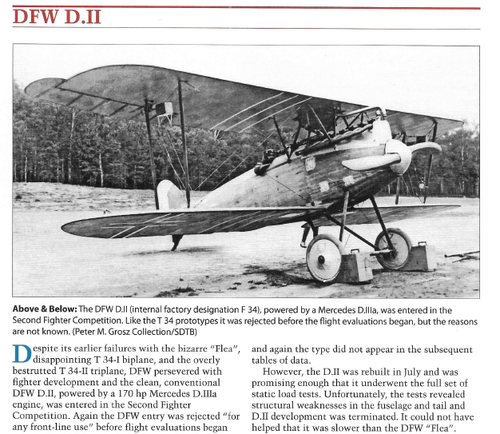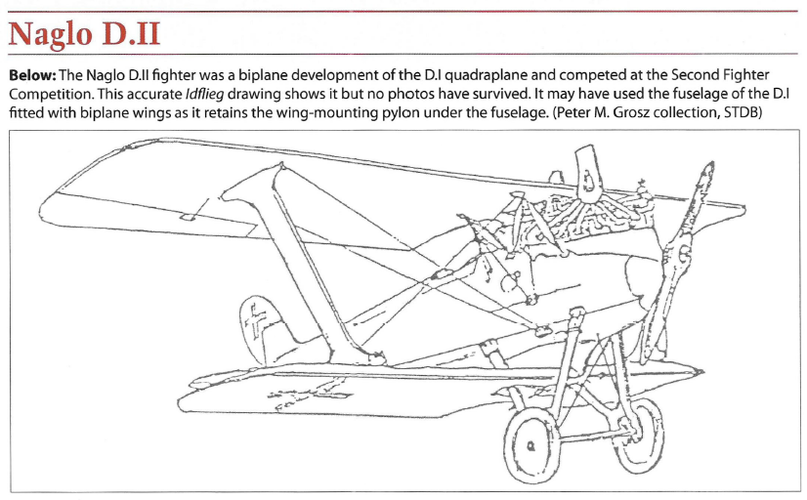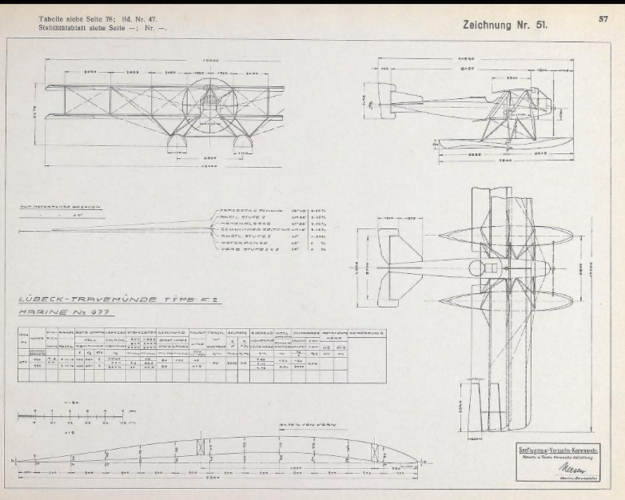You are using an out of date browser. It may not display this or other websites correctly.
You should upgrade or use an alternative browser.
You should upgrade or use an alternative browser.
German WW1 Fighters and Recce Aircraft Prototypes and Projects
- Joined
- 25 July 2007
- Messages
- 4,297
- Reaction score
- 4,183
According to Wikipedia, this is the Schütte Lanz C II prototype misidentified as an AGO C VIII.
Other sources (eg: airwar.ru) identify that Wiki photo as the AGO C VII/2. If that is accurate, then the AGO C VIII/1 was, instead, a 3-bay biplane ...
... and we're no closer to the Schütte Lanz C II
Other sources (eg: airwar.ru) identify that Wiki photo as the AGO C VII/2. If that is accurate, then the AGO C VIII/1 was, instead, a 3-bay biplane ...
... and we're no closer to the Schütte Lanz C II
Tuizentfloot
ACCESS: Secret
- Joined
- 9 May 2010
- Messages
- 270
- Reaction score
- 152
Unfortunately no further information. The end of WW1 was a very confused time...From, Gotha Aircraft of WWI,
the Gotha WD.28.
Tuizentfloot
ACCESS: Secret
- Joined
- 9 May 2010
- Messages
- 270
- Reaction score
- 152
No more information...From, Pfalz Aircraft of WWI,
a three C-Type Projects.
- Joined
- 26 May 2006
- Messages
- 34,810
- Reaction score
- 15,695
Siemens-Schuckert Bulldog was a monoplane of 1915,powered by one Siemens Sh I
or Mercedes D I engine,no more details are known,and if it was a fighter or not ?.
From, Siemens-Schuckert Aircraft of WWI
Attachments
Tuizentfloot
ACCESS: Secret
- Joined
- 9 May 2010
- Messages
- 270
- Reaction score
- 152
As usual very complete information.
Tuizentfloot
ACCESS: Secret
- Joined
- 9 May 2010
- Messages
- 270
- Reaction score
- 152
From, Roland Aircraft of WWI,
a rare picture to LFG/Roland D.VI,and unknown airplane ?.
No more information on this unknown aircraft.
The books in this series are a must for those interested in German WW1 aviation.
Tuizentfloot
ACCESS: Secret
- Joined
- 9 May 2010
- Messages
- 270
- Reaction score
- 152
D.VI prototypes: one with Daimler-Mercedes D.III, 160 hp, and two with Benz Bz.IIIa, 185 hp.Many thanks to you my dear Tuizentfloot,
and as I know,there was LFG D.VI,DVIa & D.VIb,all of them powered by one Mercedes D III engine
D.VIa series with Daimler-Mercedes D.IIIa, 170 hp. Lange mentions also the D.IIIaü (Typenhandbuch, p. 74).
D.VIb series with Benz Bz.IIIa.
Airborne2001
ACCESS: Secret
- Joined
- 19 June 2020
- Messages
- 224
- Reaction score
- 277
Pfalz D.XV



All info is from this source (I know it is not the best source, sorry.):

 en.wikipedia.org
en.wikipedia.org
General characteristics
The Pfalz D.XV was a fighter entered into the October 1918 D-Type contest. The fighter had excellent performance qualities; they actually in many ways matched those of the Fokker D.VII. The Pfalz D.XV is definitely among the best fighter aircraft produced during the First World War. The D.XVf had ailerons that were not aerodynamically balanced, and the D.XV (Spezial) had ailerons that were balanced and overhung. Over all, it is an amazing aircraft, though unfortunately it was tested too late to enter combat in time before the Armistice was signed.
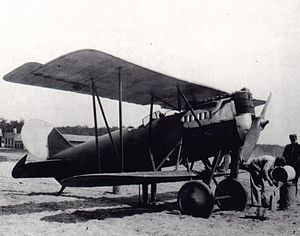


All info is from this source (I know it is not the best source, sorry.):

Pfalz D.XV - Wikipedia
General characteristics
- Crew: One
- Length: 6.50 m (21 ft 4 in)
- Wingspan: 8.60 m (28 ft 3 in)
- Height: 2.70 m (8 ft 10 in)
- Wing area: 20.00 m2 (215.3 sq ft)
- Empty weight: 738 kg (1,627 lb)
- Gross weight: 918 kg (2,024 lb)
- Powerplant: 1 × BMW IIIa 6-cylinder water-cooled inline engine, 138 kW (185 hp)
- Propellers: 2-bladed
- Maximum speed: 203 km/h (126 mph, 110 kn) at 4,000 m (13,215 ft)
- Endurance: 1.5 hr
- Time to altitude: 2.0 min to 1,000 m (3,280 ft)
The Pfalz D.XV was a fighter entered into the October 1918 D-Type contest. The fighter had excellent performance qualities; they actually in many ways matched those of the Fokker D.VII. The Pfalz D.XV is definitely among the best fighter aircraft produced during the First World War. The D.XVf had ailerons that were not aerodynamically balanced, and the D.XV (Spezial) had ailerons that were balanced and overhung. Over all, it is an amazing aircraft, though unfortunately it was tested too late to enter combat in time before the Armistice was signed.
Tuizentfloot
ACCESS: Secret
- Joined
- 9 May 2010
- Messages
- 270
- Reaction score
- 152
Hi,
as I know,the Hansa-Brandenburg KDW appeared in three variants at first,then developed into KDW/2,KDW/3,KDW/4 & KDW/5 or V,what
is the differences ?.
The KDW was essentially a float plane variant of the KD or D I single seat fighter. A total of 58 KDW fighters (incl. prototypes) were built, in five production batches with little differences between them.
All were called KDW, and designations such as KDW/2, KDW/3, … didn't exist. All were classified as ED seaplanes, except those of the last batch which were E2MG.
The prototype was Marine Nr. 748 with a Benz Bz.III, 150 hp.
The 1st production batch (Marine Nr. 783-784), also with Benz Bz.III, 150 hp, were additional prototypes.
The 2nd production batch (Marine Nr. 912-921) had the Maybach IR (Mb.III), 160 hp.
The 3th production batch (Marine Nr. 1067-1076) was built with the Benz Bz.III, 150 hp, or with the Daimler (Mercedes) D.III, 160 hp.
The 4th production batch (Marine Nr. 1380-1394) had the Maybach IR (Mb.III), 160 hp, and additional interplane struts.
The 5th production batch (Marine Nr. 1554-1573) had the Maybach IR (Mb.III), 160 hp, and additional interplane struts, but also a fixed fin, and was armed with two machine guns (hence E2MG).
My records list the Swedish Caspar S.1 as the same aircraft as the Heinkel He.1, which makes sense since Heinkel was, I believe, a Hansa-Brandenburg designer. Sweden's He.2, He.4, and He.5 look almost identical except for engines. Post-war, the S.1/He.1 and generally similar Heinkel types seem to have been in mass-production, at least relatively speaking.The Hansa-Brandenburg W-37.
Hansa-Brandenburg Aircraft of WWI Vol.3 Monoplane Seaplanes
Norway had the Caspar S.I and Heinkel HD.33.
I've also attached photos of the German Caspar S.1 and He.1
Attachments
-
 caspars1-5.jpg62.1 KB · Views: 88
caspars1-5.jpg62.1 KB · Views: 88 -
 caspars1-7.jpg87.9 KB · Views: 80
caspars1-7.jpg87.9 KB · Views: 80 -
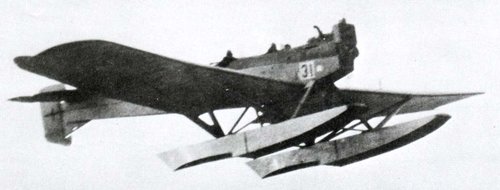 caspars1-8.jpg50.2 KB · Views: 79
caspars1-8.jpg50.2 KB · Views: 79 -
 he1-3.jpg37.2 KB · Views: 76
he1-3.jpg37.2 KB · Views: 76 -
 he1-5.jpg78.2 KB · Views: 76
he1-5.jpg78.2 KB · Views: 76 -
 he1-4.jpg105.4 KB · Views: 73
he1-4.jpg105.4 KB · Views: 73 -
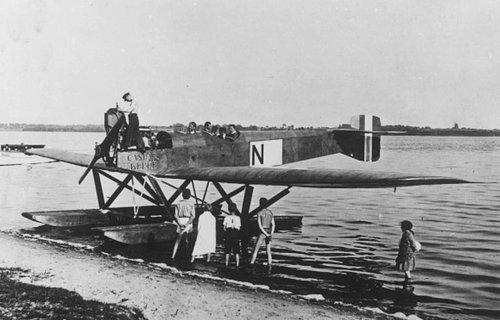 caspars1-2.jpg82.5 KB · Views: 75
caspars1-2.jpg82.5 KB · Views: 75 -
 Norsk_Heinkel_HD33.jpg16.4 KB · Views: 69
Norsk_Heinkel_HD33.jpg16.4 KB · Views: 69 -
 caspars1-6.jpg64.7 KB · Views: 71
caspars1-6.jpg64.7 KB · Views: 71 -
 he1-2.jpg72.7 KB · Views: 85
he1-2.jpg72.7 KB · Views: 85
Aubi
ACCESS: Secret
Yep, Caspar S 1 was retroactively named Heinkel HE 1. Caspar was a GERMAN company based at Lübeck-Travemünde that was founded in 1917 by former employes of Hansa und Brandenburgische Flugzeugwerke. Heinkel joined Caspar after the war (I think) and designed their first independent airplanes - previously they built Albatroses and Friedrichshafens. Because of the ban on military aviation in Germany, Caspars bought by Sweden were formally manufactured there under licence by Svenska Aero AB at Lidingö, which was one of those companies specifically set up to help German manufacturers to move around the ban and usually only put together pre-made German machines and aded the military equipment.
Caspar S 1 was based on the Hansa-Brandenburg W-29, which was also Heinkel's design, but I doubt that it had W-designation. S 1 was in turn the origin of the very succesful Heinkel HE 5 (In 1923 Heinkel left Caspar and due to legal dispute, Caspar S 1 was renamed HE 1 - Heinkel Eindecker 1. Even later, after Heinkel droped the Eindecker-Doppeldecker dichotomy, it became He-1.).
Side note: on that picture labeled HD.33 is definitely not a HD.33. As the name sugest, that was a biplane and only one was built.Aircraft on the picture seem to be HE 1 or maybe one of the early HE 5. Edit: It's actually Hansa-Brandenburg W.33, yet another evolution of the original W.29 built in small number at the end of the war and later sold to Finland and Norway. Sweden was the sole operator of military Caspars of any type, except for the Caspar U 1 tested in the USA and Japan.
Picture He1-5 is actually Heinkel HE 2 aka Rolls-Hansa. With German designation, so maybe a prototype.
Caspar S 1 was based on the Hansa-Brandenburg W-29, which was also Heinkel's design, but I doubt that it had W-designation. S 1 was in turn the origin of the very succesful Heinkel HE 5 (In 1923 Heinkel left Caspar and due to legal dispute, Caspar S 1 was renamed HE 1 - Heinkel Eindecker 1. Even later, after Heinkel droped the Eindecker-Doppeldecker dichotomy, it became He-1.).
Side note: on that picture labeled HD.33 is definitely not a HD.33. As the name sugest, that was a biplane and only one was built.
Picture He1-5 is actually Heinkel HE 2 aka Rolls-Hansa. With German designation, so maybe a prototype.
Last edited:
- Joined
- 26 May 2006
- Messages
- 34,810
- Reaction score
- 15,695
Karl Krieger is good known. He built his airplanes at Johannisthal by Berlin. Born 1885 at Krefeld.
K.K.1 from 1910 Monoplane
K.K.2 from 1911 Monoplane
K.K.3 from 1912 a Taube-Type
K.K.4 from 1913 a racing monoplane
K.K.5 from1913 Monoplane
Torpedo-Lancier-Flugzeug Triplane with floats Project
From, German Aircraft of Minor Manufacturers in WWI Vol.2,
maybe called KK.6 ?,a Torpedo Triplane Project.
Attachments
- Joined
- 11 March 2006
- Messages
- 8,620
- Reaction score
- 3,767
The "Superhansa" Project SA-15 was based on the Heinkel He 8, but wasn't really a German project
anymore, neither it was from WW I, so it got an own thread here :
https://www.secretprojects.co.uk/threads/svenska-aero-ab-prototypes-projects.36316/
anymore, neither it was from WW I, so it got an own thread here :
https://www.secretprojects.co.uk/threads/svenska-aero-ab-prototypes-projects.36316/
Tuizentfloot
ACCESS: Secret
- Joined
- 9 May 2010
- Messages
- 270
- Reaction score
- 152
My dear hesham, for the pre- to post-war history of Flugzeugwerke Rahtjen/Germania Flugzeugwerke a recent (2020) excellent book is Michael Düsing, Germania Flugzeugwerke and its aircraft (Aeronaut Books).
Your list seems correct (now we know more about the C.III), except for the so-called C-Typ (one of the variants of the C.I???).
Your list seems correct (now we know more about the C.III), except for the so-called C-Typ (one of the variants of the C.I???).
- Joined
- 26 May 2006
- Messages
- 34,810
- Reaction score
- 15,695
Flugzeugwerft Lübeck-Travemünde GmbH at Travemünde-Priwall on the Baltic coast was founded in June 1914 by the Leipzig-Lindenthal based Deutsche Flugzeugwerke DFW specially for the construction of naval aircraft.
Was there F.3 ?.
richard B
ACCESS: Secret
- Joined
- 17 August 2006
- Messages
- 343
- Reaction score
- 498
Flugzeugwerft Lübeck-Travemünde GmbH at Travemünde-Priwall on the Baltic coast was founded in June 1914 by the Leipzig-Lindenthal based Deutsche Flugzeugwerke DFW specially for the construction of naval aircraft.
Was there F.3 ?.
 View attachment 691200
View attachment 691200F.3 : 150 hp Benz Marine Nr 844 ( or 845???) .1918
Airborne2001
ACCESS: Secret
- Joined
- 19 June 2020
- Messages
- 224
- Reaction score
- 277
I found this adorable little aircraft recently (top of the page):

 plane-encyclopedia.com
(Credit to this website for all images as well.)
plane-encyclopedia.com
(Credit to this website for all images as well.)
The DFW Floh was a fighter design with rather interesting dimensions. The fighter was designed with speed in mind, and achieved 180KPH in flight (it should be noted that for 1915 this was fast). However, the design unfortunately had very poor visibility towards the ground.


The following image reveals the poor visibility towards the ground as the pilot had to stand up to see:

Medicman11
 plane-encyclopedia.com
plane-encyclopedia.com
The DFW Floh was a fighter design with rather interesting dimensions. The fighter was designed with speed in mind, and achieved 180KPH in flight (it should be noted that for 1915 this was fast). However, the design unfortunately had very poor visibility towards the ground.
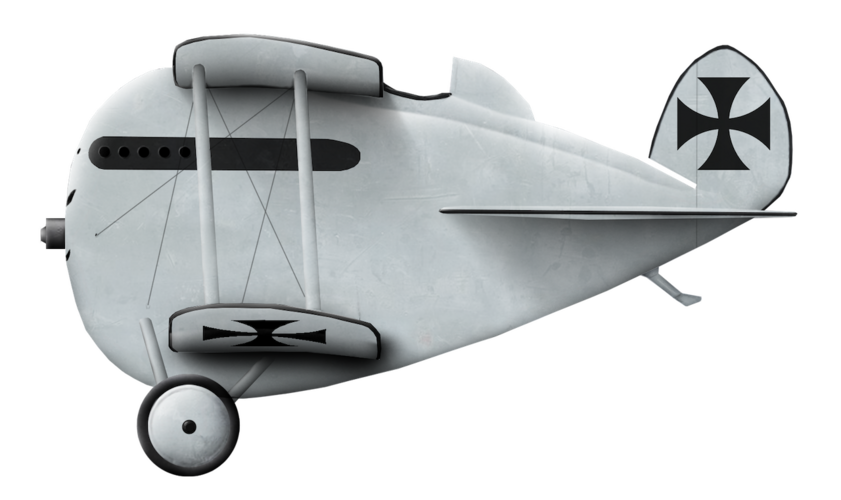

The following image reveals the poor visibility towards the ground as the pilot had to stand up to see:
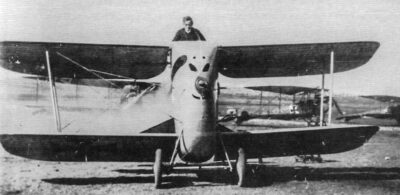
Similar threads
-
-
Experimental ww1 fighters from Albatros and Siemens
- Started by T-50
- Replies: 12
-
Friedrichshafen Little Known Prototypes & Projects
- Started by hesham
- Replies: 16
-
LFG (Luft-Fahrzeug-Gesellschaft) Projects
- Started by hesham
- Replies: 21
-








